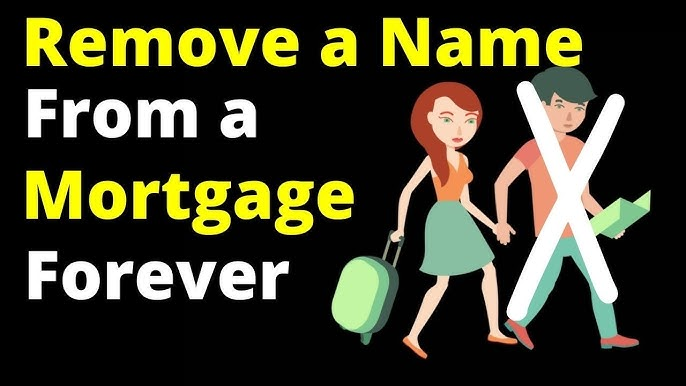
How Do I Get My Name Off a Mortgage Loan?
Getting your name off a mortgage loan can be a daunting task, especially if you’re unfamiliar with the process. Whether due to a divorce, separation, or a change in personal circumstances, removing your name from a mortgage requires careful consideration and several steps. This guide will walk you through the process, ensuring you understand the options available and the potential implications of each.
Understanding the Mortgage Agreement
Before diving into the process of removing your name from a mortgage, it’s crucial to understand your current mortgage agreement. This document outlines the terms of your loan, including who is responsible for payments. If your name is on the mortgage, you are legally obligated to ensure the payments are made, even if you no longer live in the home.
Key Components of a Mortgage Agreement
The mortgage agreement is a comprehensive document that details various aspects of the loan. It includes the loan amount, interest rate, repayment schedule, and any penalties for late payments. Understanding these elements is critical as they dictate your financial obligations and the consequences of failing to meet them.
Legal Obligations and Responsibilities
Being a co-signer on a mortgage comes with legal responsibilities. Even if you aren’t living in the home, you are still legally bound to ensure the mortgage payments are made. This means that any missed payments can negatively impact your credit score and result in legal action from the lender.
Importance of Reviewing the Agreement
Before initiating the process of removing your name, thoroughly review your mortgage agreement. Look for clauses related to refinancing, loan assumption, or any other options that could facilitate the removal of your name. Consulting with a mortgage professional can also provide clarity on complex terms and conditions.
Why Remove Your Name from a Mortgage?
There are various reasons why someone might want to remove their name from a mortgage. Common scenarios include:
Divorce or Separation
In the case of a divorce, one partner may wish to have their name removed from the mortgage if they are no longer residing in the home. Removing your name can simplify the division of assets and liabilities, allowing both parties to move forward financially independent of each other.
Financial Independence
Removing your name from a mortgage can help improve your credit score and allow you to pursue new financial opportunities. By freeing yourself from the debt obligation, you can apply for new loans, credit cards, or mortgages without the burden of the existing mortgage affecting your creditworthiness.
Property Sale or Transfer
Sometimes, removing a name is part of selling the property or transferring ownership to another party. This is often the case when one party wishes to sell their share of the property to the other party or when the property is being sold to a third party. Understanding your reasons can help determine the best approach for removing your name from the mortgage.
Options for Removing Your Name from a Mortgage

There are several ways to remove your name from a mortgage, each with its own set of requirements and implications. Let’s explore the most common options:
Refinancing the Mortgage
Refinancing involves taking out a new loan to pay off the existing mortgage. This option requires the remaining borrower to qualify for a new mortgage based on their credit score and financial situation. Here’s how it works:
Application Process
The remaining borrower applies for a new mortgage. If approved, the new loan pays off the existing mortgage, effectively removing your name from the debt obligation. This process can be complex, requiring documentation such as income verification, credit reports, and asset statements to assess the borrower’s ability to meet the new loan terms.
Costs and Fees
Refinancing can incur costs such as appraisal fees, closing costs, and other charges. It’s essential to weigh these expenses against the benefits of removing your name. Evaluating the break-even point of refinancing can help determine if the potential savings outweigh the upfront costs involved.
Credit Impact
Refinancing can impact the credit scores of both parties, so consider consulting with a financial advisor before proceeding. The inquiry and approval process might temporarily lower your credit score, but successfully refinancing can improve it in the long term by eliminating your name from the original mortgage liability.
Loan Assumption
Loan assumption allows the remaining borrower to take over the existing mortgage without refinancing. Not all mortgages are assumable, so it’s important to check with your lender first. Here’s a breakdown of the process:
Eligibility
Verify if your mortgage is assumable. If it is, the remaining borrower must demonstrate their ability to make the payments. This typically involves a financial assessment similar to that of a new loan application, ensuring the borrower can meet the lender’s requirements.
Approval Process
The lender will assess the financial situation of the remaining borrower. If approved, your name will be removed from the mortgage. This process can take time, and the borrower may need to provide additional documentation to satisfy the lender’s criteria.
Lender Fees
Some lenders charge a fee for processing a loan assumption, so be sure to inquire about any associated costs. Understanding these fees in advance can help you and the remaining borrower plan financially for the transition.
Selling the Property
Selling the property is a straightforward way to remove your name from a mortgage. If both parties agree to sell, the proceeds from the sale can be used to pay off the mortgage. Consider the following steps:
Market Evaluation
Determine the current market value of your property to set a competitive price. Conducting a comparative market analysis with the help of a real estate agent can provide insights into property values in your area, helping you set an appropriate listing price.
Agreement to Sell
Both parties must agree on the sale terms and work together to list the property. This collaboration involves preparing the property for sale, marketing it, and potentially negotiating with buyers to achieve the best possible outcome.
Closing Process
Once the property is sold, the mortgage is paid off, and your name is removed. During the closing process, all financial obligations are settled, ensuring that any remaining debts are cleared and ownership is transferred seamlessly.
Quitclaim Deed
A quitclaim deed transfers ownership rights of the property to another party, typically used in divorce settlements. However, this does not remove your name from the mortgage itself. Here’s what to know:
Ownership Transfer
The deed relinquishes your ownership rights, but you remain liable for the mortgage unless the loan is refinanced or assumed. This means that while you no longer have a stake in the property, the financial responsibility remains unless additional steps are taken.
Legal Advice
Consulting with a legal expert is advisable to understand the implications fully. They can help you navigate the complexities of property and mortgage laws, ensuring that your rights and obligations are clearly defined and protected.
Challenges and Considerations

Removing your name from a mortgage is not without its challenges. Here are some considerations to keep in mind:
Credit Score Impact
Any late payments or defaults can affect your credit score even if you no longer reside in the home. It’s crucial to ensure that payments are made consistently until your name is officially removed to protect your credit standing.
Financial Responsibility
Until your name is officially removed, you remain responsible for the mortgage payments. This means that if the remaining borrower fails to make payments, you could be held liable, affecting your financial stability and creditworthiness.
Lender Approval
All options require lender approval, which can be challenging if the remaining borrower does not meet the financial criteria. Understanding the lender’s requirements and preparing accordingly can increase the likelihood of a successful application.
Seeking Professional Assistance

Navigating the complexities of removing your name from a mortgage can be overwhelming. Seeking professional assistance from financial advisors, mortgage brokers, or legal experts can provide valuable guidance. They can help you understand the implications of each option and assist in making informed decisions.
Financial Advisors
Financial advisors can offer insights into the best financial strategies for your situation. They can help you evaluate the long-term impacts of removing your name from a mortgage and guide you toward achieving your financial goals.
Mortgage Brokers
Mortgage brokers have expertise in securing favorable loan terms and can assist in the refinancing or loan assumption process. Their knowledge of the mortgage industry can simplify the application process and improve your chances of success.
Legal Experts
Legal experts can provide clarity on the legal ramifications of removing your name from a mortgage. They can ensure that all legal documents are correctly handled and that your rights are protected throughout the process.
Conclusion
Removing your name from a mortgage requires careful planning and consideration. Understanding your mortgage agreement, exploring available options, and seeking professional advice are essential steps in the process. By taking the appropriate actions, you can successfully navigate this transition and achieve your financial goals.
Remember, each situation is unique, so it’s crucial to assess your circumstances and choose the option that best aligns with your needs and objectives. Through informed decision-making and professional guidance, you can effectively manage this financial transition and move toward a more secure financial future.




